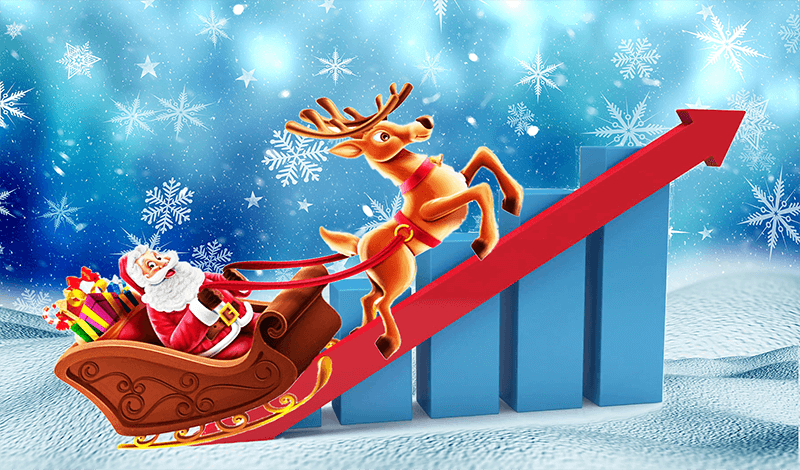Who is Santa Claus? Everyone knows that this is a gray-bearded plump old man who manages to climb into the chimney at Christmas to give gifts to those children who have been good all year. But it turns out that gifts can be received not only by obedient kids, but also by traders and investors, regardless of their behavior in the past year.
Every December, Wall Street and other global exchanges start talking about Santa Claus Rally: days when market participants have the opportunity, if not to get rich, then at least to seriously improve their financial condition. So, what is Santa Claus Rally: a real economic phenomenon or just a fairy tale for adults?
Fears and Hopes of Market Players
The situation in the stock markets is largely seasonal, determined by human psychology. For example, the activity of stock market players falls in the summer, the holiday mood reigns on the trading floors. And with the onset of autumn, along with black clouds, fear of the “October curse” creeps onto the stock exchanges. There have been several major collapses this month that have gone down in history. Therefore, there is a belief that it is better to get your feet out of the market on these days. But autumn is passing, and the mood of stock traders is gradually improving in anticipation of Santa Claus Rally, and trading activity is also increasing.
This seasonal phenomenon was first described in 1972 by Yale Hirsch, a well-known analyst, trader and investor. He published his observations in Stock Trader's Almanac, of which he was the founder. In addition to Santa Claus Rally, Yale Hirsch also pointed to other “statistically predictable” market phenomena, including the Presidential Election Year Cycle, January Barometer, and Best Six Consecutive Months.

When, How, and Why Santa Claus Starts His Rally
Yale Hirsch noticed that stock indices began to actively go up in the last days of December. Santa Claus Rally usually starts on the last Monday of the month and lasts seven trading days. The first day is decisive, it predicts how the rally will develop and how powerful it will be. And if the forecast turns out to be correct, the trader has many chances to make an impressive profit.
The most popular version of the occurrence of this phenomenon is the one put forward by Yale Hirsch himself. He explains the rally by the actions of institutional market participants. Investment fund managers are stepping up buying shares in blue chips and other market leaders to release more attractive annual reports. Since the market is quite thin on Christmas days and many of the participants have already gone on vacation, such players manage to push quotes up by a few percent at low cost. It should also be borne in mind that they expect to receive inflated bonuses improving their performance in this way. After that, after the end of the year, they begin to drop these shares, which leads to a traditional correction in early January.
Another explanation for Santa Claus Rally is the increasing activity of private investors by the end of the year. After receiving their 13th and sometimes 14th salary, many of them spend this money on buying shares. And this also affects stock prices.
NordFX offers its clients the opportunity to CFD-trade indices and shares of almost all companies that usually participate in Santa Claus Rally. Over the past two decades, market expectations regarding their pre-New Year dynamics have in many cases been met. However, the COVID-19 pandemic and the subsequent actions of the US Federal Reserve and the Central Banks of other developed countries have already made their own adjustments to the statistics, and may again make them in the future. Therefore, traders taking part in this rally should definitely be aware of the risks so as not to spoil their festive mood.
What about Forex?
But on Forex, unlike the stock market, the situation is somewhat different, and Santa Claus is much less likely to arrange a rally here. Moreover, he can direct his sleigh not only up, to the north, but also to the south. Where, gliding across the thin ice of melted liquidity, it may well fail and sink to the bottom.
As a rule, exchange trading calms down on the eve of the Catholic Christmas in the US and other countries, which is celebrated on December 25. Most players take profits and go on vacation on the eve of this event. The market is falling asleep. However, it becomes unusually thin and therefore prone to unexpected short-term ups and downs. And, as you know, volatile markets can bring not only serious profits, but no less serious losses.
That is, Forex these days either sleeps, and therefore it is useless to trade on it, or it explodes unpredictably, and therefore it is dangerous to trade on it. In addition, due to low liquidity, brokers are forced to widen spreads. It is for these three reasons that many experts recommend closing all trading orders for currency pairs before December 25 and not opening new ones until January 4, when the markets come out of their holiday hibernation. It is better to relax on these days and enter the New Year with renewed vigor and good mood.
Go Back Go Back
